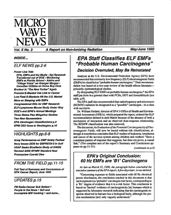News & Comment
Video Illustrates the Wonders of Nature and Teaches Us a Lesson About Our EM World

Tuesday, January 7, 2014
Danish Cancer Society Plays Games with Brain Cancer Rates
Friday, December 13, 2013
Last updated February 23, 2016
The Melatonin Hypothesis Revisited
Wednesday, September 25, 2013
Last updated October 7, 2013
Fourth Study To Show Tumor Link
Is This Really Prospective Epidemiology?
Friday, May 10, 2013
Last updated October 6, 2013
An Industry Insider Speaks Out
Tuesday, April 2, 2013
Last updated November 11, 2014

